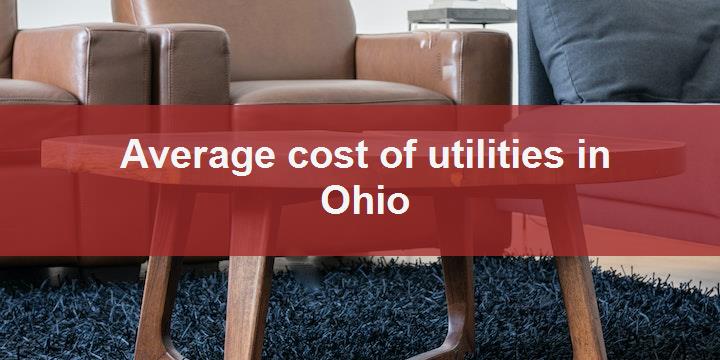Firstly, it should be noted that the average cost of utilities in Ohio can vary significantly depending on a variety of factors. However, taking into account the most important considerations for consumers, such as energy usage and availability of alternative energy sources, the total cost of utilities in Ohio per month in 2024 is approximately $420 to $600. This figure is expected to remain relatively stable compared to previous years, with only minor fluctuations due to changes in pricing and availability of resources. Overall, it is important for consumers to stay informed about their energy usage and explore options for reducing their utility costs, such as through energy-efficient technologies and renewable energy sources.
Average electric bill in Ohio
In Ohio, the average monthly electric bill for 2024 stands at approximately $174.30, reflecting the state’s commitment to energy efficiency and its moderate climate. Ohio’s distinct seasons, from brisk winters to humid summers, play a significant role in shaping household electricity costs, with heating and cooling needs fluctuating throughout the year.
For a focused comparison, envision a family of three residing in a townhouse, reliant on a heater, refrigerator, and dryer during Ohio’s notably chilly winter season. This scenario sets the stage to compare Ohio’s electric costs against those in Pennsylvania, where residents face similar seasonal energy challenges.
Monthly Cost Comparison Overview
| Criteria | Ohio | Pennsylvania |
|---|---|---|
| Total Consumption (kWh) | 1,125.23 kWh | |
| Electricity Rate (cents/kWh) | 15.49 ¢/kWh | 18.15 ¢/kWh |
| Estimated Monthly Cost | $174.3 | $204.23 |
| Detailed Cost Breakdown | ||
| Base Usage: 265.23 kWh | $41.08 | $48.14 |
| Refrigerator: 120 kWh | $18.59 | $21.78 |
| Electric Heater: 650 kWh | $100.69 | $117.98 |
| Clothes Dryer: 90 kWh | $13.94 | $16.34 |
| Ohio estimated monthly cost is lower than Pennsylvania by 14.66%. | ||
A forthcoming chart will detail the historical trends of electric bills in Ohio compared to Pennsylvania, concentrating on winter consumption for a household equipped with a heater, refrigerator, and dryer. This year-over-year comparison will reveal the impact of evolving energy consumption habits and external influences on utility expenses.
Historical Monthly Electricity Costs
Wondering if your electric bill aligns with the Ohio average or curious about how it stacks up to other states, like Kentucky? Our Electricity Bill Calculator is your gateway to uncovering potential savings and enhancing your energy efficiency. Click through to gain a comprehensive understanding of your electricity costs today.
Average gas bill in Ohio
As of the most recent data, Ohio residents contend with an average monthly gas bill of approximately $80, reflecting the state’s reliance on this energy source for heating and other household needs.
Factors Influencing Gas Bills:
🏠 Residential Usage: Gas remains a prevalent choice for heating and cooking in many Ohio households, with its affordability and efficiency making it a popular option.
🌳 Abundant Natural Gas Resources: Ohio is endowed with abundant natural gas reserves, contributing to the availability and affordability of this energy source for consumers across the state.
💰 Market Dynamics: Fluctuations in natural gas prices, influenced by factors such as supply and demand, weather patterns, and geopolitical events, can impact monthly gas bills for Ohio residents.
Prevalence and Usage of Natural Gas:
Natural gas plays a significant role in Ohio’s energy landscape, with many homes relying on it for heating during the cold winters. The state’s abundant natural gas resources contribute to its affordability compared to other energy sources.
Comparison Table: Average Monthly Gas Bills Across Ohio (2024)
| City | Average Gas Bill (2024) |
|---|---|
| Columbus | $85 |
| Cleveland | $80 |
| Cincinnati | $75 |
| Dayton | $85 |
Comparison Table: Average Monthly Costs by Energy Source
| Energy Source | Average Monthly Cost |
|---|---|
| Natural Gas | $80 |
| Electricity | $110 |
| Propane | $100 |
Understanding the prevalence and usage of natural gas, along with the factors influencing gas bills, empowers Ohio residents to manage their energy expenses effectively while ensuring comfort and affordability in their homes.
Average Heating costs in Ohio
In Ohio, where winters can be chilly, residents encounter varying average heating costs depending on their chosen fuel source and heating methods. Natural gas, a popular choice for heating, comes with an average monthly cost of around $100, offering affordability and efficiency to many households across the state.
Common Heating Practices:
🔥 Natural Gas: With its widespread availability and relatively low cost, natural gas furnaces are a common choice for heating homes in Ohio, particularly in urban and suburban areas.
🛢️ Heating Oil: In rural regions where access to natural gas may be limited, some households rely on heating oil furnaces. However, the fluctuating prices of oil can result in higher heating expenses during colder months.
🔥 Propane: Similarly, propane serves as an alternative for homes without access to natural gas lines. While it provides consistent heating, its costs can be influenced by market fluctuations and supply availability.
Comparison Table: Average Monthly Heating Costs Across Ohio (2024)
| City | Average Heating Cost (Natural Gas) |
|---|---|
| Columbus | $105 |
| Cleveland | $100 |
| Cincinnati | $95 |
| Dayton | $110 |
Comparison Table: Average Monthly Costs by Heating Source
| Heating Source | Average Monthly Cost |
|---|---|
| Natural Gas | $100 |
| Heating Oil | $120 |
| Propane | $130 |
Navigating heating costs in Ohio involves understanding the trade-offs between different fuel sources, considering factors such as availability, affordability, and efficiency. By choosing energy-efficient appliances and exploring options for alternative heating methods, residents can effectively manage their heating expenses while staying warm and comfortable during the winter months.
Average Water and Sewer Fees in Ohio
Water and sewer fees typically range from $40 to $80 per month, depending on factors such as locality, usage, and infrastructure investments.
Unique Considerations for Water Usage:
💧 Water Conservation Efforts: Ohio emphasizes water conservation initiatives to mitigate water scarcity concerns and promote sustainable usage practices among residents and businesses.
🌊 Great Lakes Access: Being bordered by Lake Erie, Ohio has access to abundant freshwater resources, but ensuring water quality and conservation remains a priority due to industrial and agricultural activities affecting water bodies.
🚰 Infrastructure Maintenance: Ongoing investments in water treatment plants, distribution networks, and sewage systems contribute to the reliability and quality of water and sewer services, influencing fee structures for consumers.
Comparison Table: Average Monthly Water Fees Across Ohio (2024)
| City | Average Water Fee (per month) |
|---|---|
| Columbus | $50 |
| Cleveland | $60 |
| Cincinnati | $45 |
| Dayton | $55 |
Comparison Table: Average Monthly Sewer Fees Across Ohio (2024)
| City | Average Sewer Fee (per month) |
|---|---|
| Columbus | $30 |
| Cleveland | $35 |
| Cincinnati | $25 |
| Dayton | $40 |
Navigating water and sewer fees in Ohio involves understanding local regulations, consumption patterns, and infrastructure investments. By participating in conservation efforts and staying informed about water usage best practices, residents can contribute to both environmental sustainability and cost-effective water management in their communities.
Garbage/Trash Removal Costs in Ohio
Garbage removal fees typically range from $20 to $40 per month per household, reflecting the costs of collection, transportation, and disposal of waste materials.
Waste Management Programs:
🗑️ Curbside Collection Services: Many municipalities in Ohio offer curbside collection services for garbage and recycling, providing convenient disposal options for residents while ensuring compliance with waste management regulations.
♻️ Recycling Initiatives: Ohio boasts robust recycling programs aimed at diverting waste from landfills and promoting sustainable waste management practices. Residents are encouraged to participate in recycling programs to reduce overall waste disposal costs.
🌳 Green Waste Programs: Some communities in Ohio may also have green waste programs in place, facilitating the disposal of organic waste such as yard trimmings and food scraps through composting or mulching initiatives.
Comparison Table: Average Monthly Garbage Removal Costs Across Ohio (2024)
| City | Average Garbage Removal Fee (per month) |
|---|---|
| Columbus | $30 |
| Cleveland | $25 |
| Cincinnati | $35 |
| Dayton | $40 |
Comparison Table: Average Monthly Recycling Costs Across Ohio (2024)
| City | Average Recycling Fee (per month) |
|---|---|
| Columbus | $10 |
| Cleveland | $15 |
| Cincinnati | $12 |
| Dayton | $8 |
Navigating garbage and recycling costs in Ohio involves understanding local waste management programs, disposal regulations, and available services. By participating in recycling initiatives and exploring waste reduction strategies, residents can contribute to environmental sustainability while managing disposal expenses effectively.
Internet and Cable TV Expenses in Ohio
The average monthly expenses for these services typically range from $60 to $150, depending on factors such as service speed, channel lineup, and bundled packages.
Popular Providers:
🖥️ Spectrum: Spectrum is one of the leading providers of internet and cable TV services in Ohio, offering a range of packages with varying internet speeds and channel options to cater to different households’ entertainment needs.
📡 AT&T: AT&T provides reliable internet and cable TV services across Ohio, with options for fiber-optic internet connections and customizable TV packages to suit individual preferences.
📶 Xfinity by Comcast: Xfinity offers a wide range of internet and cable TV plans in Ohio, with features such as on-demand content, streaming services integration, and advanced DVR capabilities to enhance the viewing experience.
Comparison Table: Average Monthly Internet Expenses Across Ohio (2024)
| Provider | Average Monthly Cost |
|---|---|
| Spectrum | $70 |
| AT&T | $65 |
| Xfinity by Comcast | $75 |
Comparison Table: Average Monthly Cable TV Expenses Across Ohio (2024)
| Provider | Average Monthly Cost |
|---|---|
| Spectrum | $80 |
| AT&T | $85 |
| Xfinity by Comcast | $90 |
Navigating internet and cable TV expenses in Ohio involves considering factors such as coverage, reliability, and available features from popular providers like Spectrum, AT&T, and Xfinity by Comcast. By comparing plans and exploring promotional offers, residents can find options that best fit their entertainment needs and budget preferences.
Home Phone and Mobile Phone Costs in Ohio
In Ohio, residents encounter varying costs for both home phone and mobile phone services, reflecting the diverse communication needs and preferences across the state. Home phone services typically range from $20 to $40 per month, providing traditional landline connectivity for local and long-distance calls.
Mobile phone plans in Ohio present a wide range of options, with average monthly costs varying between $30 to $70. Factors such as data allowance, call minutes, and additional features influence these expenses, catering to individual communication requirements.
Key Points:
📞 Home Phone Services: Traditional home phone services remain prevalent in many Ohio households, offering reliable landline connections for local and long-distance calls.
📱 Mobile Phone Plans: With the rise of mobile technology, mobile phone plans have become the primary mode of communication for individuals and families in Ohio. The average monthly cost varies based on factors such as data allowance, call minutes, and additional features tailored to modern communication needs.
Comparison Table: Average Monthly Home Phone Costs Across Ohio (2024)
| Provider | Plan Details | Monthly Cost |
|---|---|---|
| AT&T | Home Phone | $25 |
| Spectrum | Voice Unlimited | $30 |
| Frontier Communications | Basic Home Phone | $35 |
Comparison Table: Average Monthly Mobile Phone Costs Across Ohio (2024)
| Provider | Plan Details | Monthly Cost |
|---|---|---|
| Verizon Wireless | Unlimited Talk, Text & Data | $50 |
| T-Mobile | Magenta MAX | $60 |
| AT&T | Unlimited Elite | $70 |
By exploring options from providers such as AT&T, Spectrum, and Frontier Communications for home phone services, and major carriers like Verizon Wireless, T-Mobile, and AT&T for mobile phone plans, Ohio residents can select plans tailored to their communication needs and budget preferences, ensuring seamless connectivity throughout the state.
FAQ
Q: 💡 What is the average monthly electric bill in Ohio in 2024? A: The average monthly electric bill in Ohio in 2024 stands at approximately $174.30.
Q: 🔥 What is the average monthly gas bill for Ohio residents in 2024? A: Ohio residents contend with an average monthly gas bill of approximately $80 in 2024.
Q: 🔥 What is the average monthly cost of natural gas for heating in Ohio? A: Natural gas, a popular choice for heating, comes with an average monthly cost of around $100 in Ohio.
Q: 💧 What is the range of water and sewer fees in Ohio per month? A: Water and sewer fees typically range from $40 to $80 per month in Ohio.
Q: 🗑️ What are the typical monthly fees for garbage removal in Ohio? A: Garbage removal fees typically range from $20 to $40 per month per household in Ohio.
Q: 🌐 What are the typical monthly expenses for internet and cable TV in Ohio? A: The average monthly expenses for internet and cable TV services typically range from $60 to $150 in Ohio.
Q: 📞 How much do home phone services cost per month in Ohio? A: Home phone services typically range from $20 to $40 per month in Ohio.
Q: 📱 What are the average monthly costs for mobile phone plans in Ohio? A: Mobile phone plans in Ohio present a wide range of options, with average monthly costs varying between $30 to $70.
Q: 💰 What is the total cost of utilities in Ohio per month in 2024? A: The total cost of utilities in Ohio per month in 2024 is approximately $420 to $600.
Also Reading
Everett average rent
Bozeman average rent
Allentown pros and cons of living




